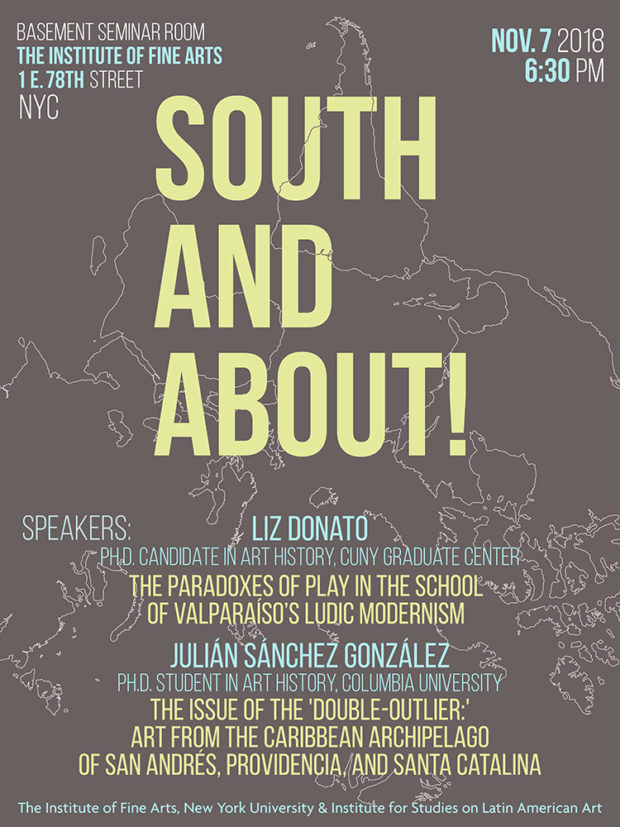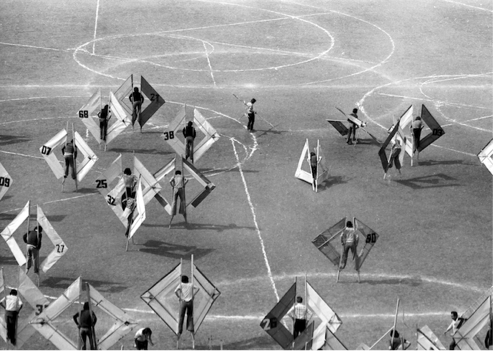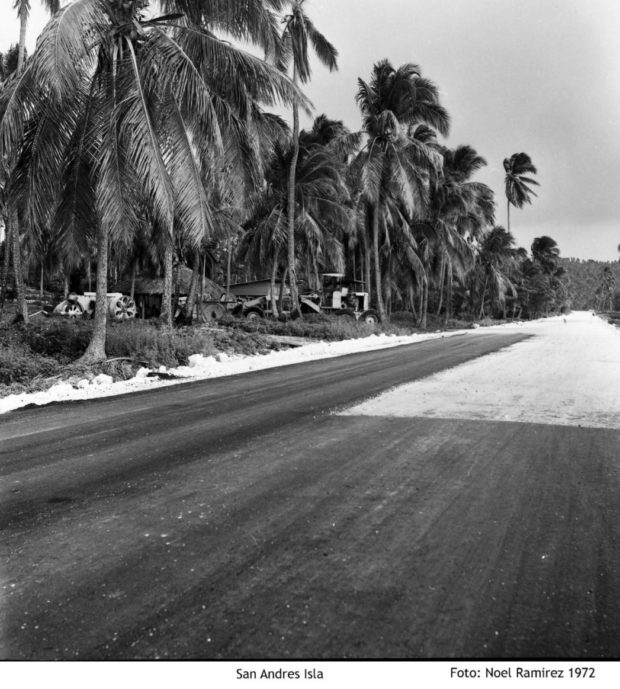South and About! Fall 2018
November 7th
South & About! is a student-organized research workshop on the arts from Latin America and the Caribbean. This program invites graduate students and emerging scholars in art history and related disciplines to participate in informal discussions amongst their peers.
The Paradoxes of Play in the School of Valparaíso’s Ludic Modernism
Liz Donato, Ph.D. Candidate in Art History, CUNY Graduate Center
In the early 1950s, Argentine poet Godofredo Iommi and Chilean architect Alberto Cruz transformed the industrial port city of Valparaíso into ludic terrain, launching one of the most idiosyncratic pedagogical experiments in postwar architectural culture. Known as the “Valparaíso School,” this group of poet-architects conceived the social and spatial dimensions of el juego as an ephemeral architecture that subverted the inert geometries of rational functionalism. This presentation focuses on the concept and heterogeneous forms of el juego in the Valparaíso School’s corpus, from its engagement with Surrealist tactics, such as the exquisite corpse and improvised poetic actions, to the tournaments that evolved from the “Culture of the Body” course in the early 1970s. In this latter context, architect Manuel Casanueva expanded his research on the history of the modern game to design tournaments that encompassed references to sports history, popular culture, myth, and ritual. The first part of my presentation will situate the group’s ludic actions within a broader genealogy of Latin American avant-gardes that privileged playful, sensorial modes of interactivity (e.g. MADI and the Neo-Concrete group) and within the historiography of postwar architecture (which tends to overlook manifestations of homo ludens beyond more canonical European cases). The remainder of my talk will critically examine how Roger Caillois’ concepts of ludus (organized play, subordination to rules) and paidia (free, spontaneous play) often overlapped in the tournaments—even the most rigidly structured games contained the potential for failure, improvisation, and re-invention. Student-participants were thus able to transgress certain rules, but always within a circumscribed field of relations and set of conditions. Considering these symbolic actions in the context of the military dictatorship, my presentation interrogates the extent to which the tournaments reproduced and internalized disciplinary norms imposed from without.
—
“The Issue of the ‘Double-Outlier:’ Art from the Caribbean archipelago of San Andrés, Providencia, and Santa Catalina”
Julián Sánchez González, PhD Student in Art History, Columbia University
The first half of the 1950s marked a decisive turning point for Colombian politics as a new military regime, under General Gustavo Rojas Pinilla, rose in the aftermath of the bipartisan armed confrontation known as La Violencia. The varied policies of a populist cut during Rojas’s government prominently featured the declaration of the Caribbean islands of San Andrés, Providencia, and Santa Catalina as a Free Port. The exemption of taxes to industrial and luxury goods as well as the strengthening of the touristic industry rapidly prompted a massive migration movement from mainland Colombia to the archipelago, a phenomenon that would permanently change the creole cultural landscape of these territories. The newcomers notably included artists, writers, and poets whom, inspired by the countercultural movements of the 1960s, saw these islands as a definitive scape from the strictures of modern life. In this talk, I will be focusing on the work of two of these artists, namely Noel Ramírez, a photographer, and Carson Hudgson, a painter, one mestizo and the other creole, to discuss the development of the process of artistic miscegenation taking place in San Andrés island in the 1960s and the 1970s. Foregrounding this discussion lies the argument that this generation of artists was rendered virtually invisible from canonical art narratives by virtue of their geographic location and heterogeneous composition. Through their absence, or essentialist short appearances, from Colombian and Caribbean art historiography it will be argued, following and expanding on curator Lynne Cooke’s recent work, that artists such as Ramírez and Hudgson represent a type of “double-outlier,” that is an artist working at the margins of the already marginalized, a position that gave them unparalleled creative agency to produce groundbreaking work.
—
September 17th
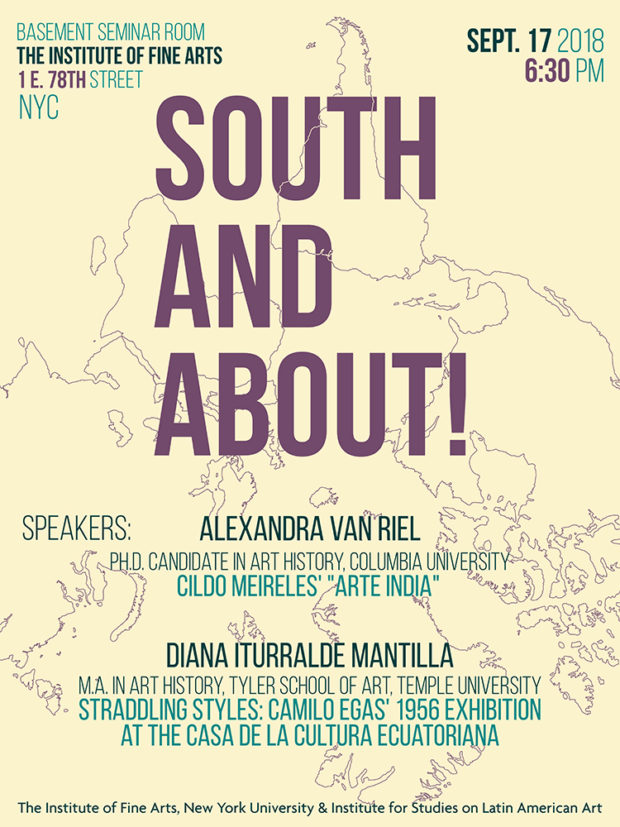
Cildo Meireles’ “Arte India”
Alexandra van Riel, Ph.D. Candidate at Columbia University’s Art History and Archeology Department.

Artists in Brazil did not adhere to Nativist art in the early part of the 20th Century in the same ways in which its neighbors did. In the second half of the nineteen-sixties Brazilian conceptual artist, Cildo Meireles became a pioneer in his engagement with the causes of indigenous populations in Brazil. Some of his works produced in two different moments, from 1969 to 1975 and from 1987 to 1989 allow us to understand the changing attitudes in Brazilian society about the place it reserved for indigenous peoples. In my paper I explore the reasons for the absence of works of art dealing with these issues until the late nineteen sixties, investigate what events in Meireles’ life allowed him to take a different position in relation to the indigenous figure in his art and analyze how social and historical changes and evolving debates are reflected in his artistic practice.
—
Straddling Styles: Camilo Egas’ 1956 Exhibition at the Casa de la Cultura Ecuatoriana
Diana Iturralde, M.A. in Art History from the Tyler School of Art at Temple University
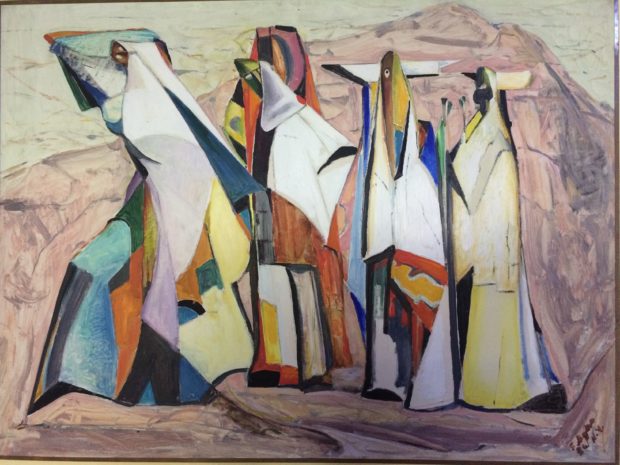
This paper examines Camilo Egas’ 1956 solo exhibition, organized by the Casa de la Cultura Ecuatoriana, and his peculiar role in the country’s artistic milieu during this decade. This unacknowledged exhibition marked his return to Ecuador after almost thirty years in New York, along with when non-representational art began to challenge Indigenismo. The responses to this event elucidated that the New York and Ecuadorian art scenes did not necessarily ascribe to the same ideas of modernism and the role of art in society. While Egas’ work changed considerably in response to the incessant mutability of a modern and diverse city during a time of postwar existentialism, the majority of Ecuadorian artists remained true to its longstanding dedication to Indigenismo and Social Realism. Egas’ most recent paintings contained representational elements that were rendered in a highly abstract and suggestive manner, establishing a conversation between figurative and non-figurative styles. By depicting familiar images of national identity –such as the Indigenous people of Ecuador– through the language of geometry and abstraction, Egas appealed to a broader audience and contributed to this stylistic transition while still acknowledging his cultural authenticity.
I based this presentation on a chapter taken from my master’s thesis: “Between New York and the Andes, Abstraction, and Indigenismo: Camilo Egas’ Paintings from the 1940s and 1950s.” To support my claims, I conducted archival research for this project from May 2017 to February 2018, during which time I visited several public archives and private holdings in both Quito, Ecuador, and New York.
